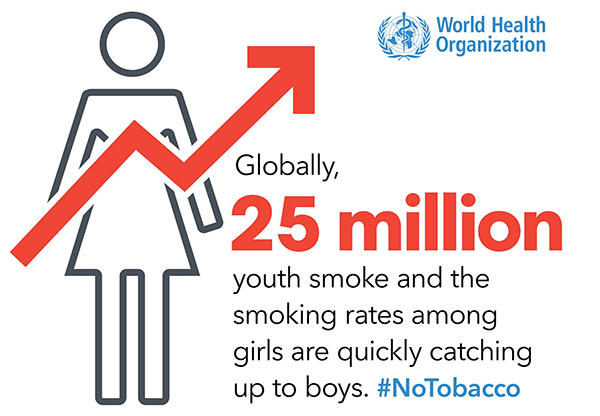The Global Economic Burden of Tobacco: An Interview with Dr. Mark Parascandola
, by NCI Staff
NCI recently released The Economics of Tobacco and Tobacco Control, the latest in a series of monographs on tobacco use and tobacco control. Produced in collaboration with the World Health Organization, the new report examines the current research surrounding the economics of tobacco control in many countries around the world.
In this interview, Mark Parascandola, Ph.D., of NCI’s Tobacco Control Research Branch, discusses the findings.
How is this report different from others in the series of monographs on tobacco control?
The NCI Tobacco Control Monograph series aims to provide ongoing and timely information about emerging public health issues in smoking and tobacco use control. This particular monograph is the first in the series to focus entirely on tobacco control from an economic perspective. Additionally, while some of our previous monographs focus primarily on data and experience from the United States, this report, completed in collaboration with the World Health Organization (WHO), takes a global perspective.
Economic tools can be applied to tobacco control in a variety of ways. For instance, researchers can assess the impact of tax and price on tobacco use, measure the economic costs of tobacco use, characterize the manufacturing and trade of tobacco products, and consider how information and tobacco control policies influence consumer demand for tobacco products.
What are the economic costs of tobacco use around the world?
The report found that the use of tobacco burdens economies with more than US$1 trillion annually in health care costs and lost productivity. In addition to early death, tobacco users are more likely to suffer from debilitating diseases that may prevent them from working, as well as burdening family members and other caregivers. We also found that among poor households, tobacco use can exacerbate poverty by increasing health care costs, reducing incomes, and decreasing productivity, as well as by diverting limited family resources away from basic needs.
Are there any negative economic effects from reducing tobacco use, such as reduced income for tobacco farmers?
The report found that, overall, tobacco control does not harm economies. The number of jobs dependent on tobacco has already been falling in most countries, largely due to technological innovation, and for most countries tobacco control measures will have only a modest impact on employment. Additionally, there is now a large body of evidence from many countries demonstrating that smokefree policies do not adversely affect hospitality businesses, such as bars and restaurants.
Where do most of the world’s current smokers live?
There are an estimated 1.1 billion tobacco smokers aged 15 years or older worldwide, and 80% of them live in low- and middle-income countries. Due to its large population and smoking prevalence, China accounts for 40% of the world’s cigarette consumption. But Russia, the United States, and Indonesia are also relatively high tobacco consumers.
Has there been progress in reducing tobacco use globally over the past decade?
One of the major conclusions of this report is that progress is being made in controlling the global tobacco epidemic. In high-income countries like the United States, this progress has been going on over several decades. But in recent years, following the WHO Framework Convention on Tobacco Control, many low- and middle-income countries have also been implementing effective tobacco control measures.
Are there effective interventions available now to reduce tobacco use and the harmful effects of tobacco use?
Yes. Research from around the world has demonstrated the effectiveness of evidence-based interventions to reduce tobacco use, including significant tobacco tax and price increases, comprehensive bans on tobacco industry marketing, prominent pictorial health-warning labels, smokefree policies, and cessation programs. Additionally, research demonstrates that these interventions are highly cost effective.
However, these interventions remain underutilized. Global tobacco excise taxes generated nearly US$269 billion in government revenues in 2013-2014, yet governments spent less than US$1 billion during that period on tobacco control.
What did you learn by including data on low- and middle-income countries in this report?
One of the major contributions of this report was to analyze recent data from low- and middle-income countries in addition to data from high-income countries. Interestingly, we found that certain tobacco-control tools, such as raising taxes on tobacco products, can be just as effective in low- and middle-income countries as they are in high-income countries.
What areas of new research are needed?
While there are effective interventions to reduce tobacco use, ongoing research is needed to further understand the economics of tobacco control, particularly in low- and middle-income countries. Key priorities include further research on the effects of tobacco taxation and pricing, on interrelationships between tobacco use and poverty, on illicit trade, on economically viable alternatives to tobacco growing and manufacturing, and on the implementation and evaluation of the WHO Framework Convention on Tobacco Control.
Is there a take-home message from this report?
Above all, the research summarized in this monograph confirms that evidence-based tobacco control interventions make sense from an economic as well as a public health standpoint. Concerns that tobacco control will have adverse economic effects are not supported by the evidence. Given the enormous health and economic consequences of tobacco use and the rapidly evolving global market for tobacco, these interventions are needed now more urgently than ever.

